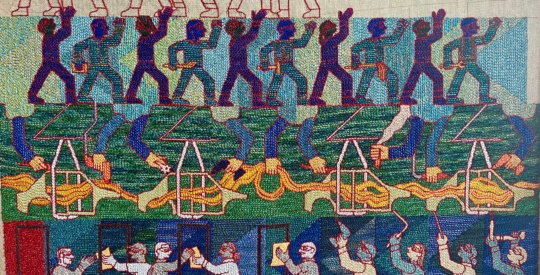
In the photographic works on view in “Gray Space” at Swan Coach House Gallery, artist Kelly Kristin Jones captured the plastic sheathing at various constructions sites, using it as a visual filter. These translucent sheaths, used to keep water and wind out of unfinished buildings, act as veils that deny us visual access to the space and architecture beyond them. This exhibition is the culmination of Jones’s 2015-16 Emerging Artist Award from the Forward Arts Foundation. For this new body of work, Jones shot buildings in downtown Atlanta from behind the protective wrappings. They are unremarkable in life, but through the artist’s lens they accomplish a surprising amount of transformation as we peer through them at plazas and large architectural structures.
Many of the photographs depict tightly focused spaces with strong geometric elements. Headquarters is a modestly scaled black-and-white print that allows us to see through a sagging veil into a plaza under construction. Our view is fully enclosed, no sky in sight. The black gantry of a crane rises up, leaning at an angle that implies movement as it passes between the curved reflections on the plastic and the gridded forms of the background buildings. The plastic and the backgrounds are more than two layers sliding over each other. They also frame the volume of space in between them. The crane emphasizes this space dynamically.

Peachtree Place V offers a view of yellow and turquoise high-rise facades looming behind plastic sheathing reinforced with a diamond-grid mesh. The yellow and blue are beach colors, and adjacent forms contain intense magentas. This photo and several others feel heavily manipulated due to Jones’s deft use of the distortion and reflections that the plastic creates. Though digitally printed, Jones does very little software manipulation of the image. Instead, the lens, the subject, and the available light are her tools of distortion and transformation.
1400 West Peachtree stands out from the others by avoiding architecture entirely. In this work, two vertical forms mimic each other. On one side, a plastic shroud, crumpled in a manner suggesting vertically stacked shapes. On the other, a plume of dark smoke moves towards the sky. This work accentuates the notions of refuse and mortality that linger quietly in the other works. The plastic operates as a shroud, bringing connotations of death and burial that make the smoke seem funerary. It is, after all, thrown away and buried in a landfill after use. 1400 West Peachtree points us towards these notions as the smoke and plastic shroud ascend side by side, literal trash and ascendant metaphor.
In her artist’s statement, Jones refers to the notion of “Gray Space” developed by Japanese architect Kisho Kurakawa, who uses the term to describe color but also to describe a transitional space between the interior and exterior of a building. Without the practical constraints of architectural function, this idea has evolved into something different in Jones’s photographs. While she does occasionally focus on the transitional spaces that Kurokawa was interested in (think plazas, atriums, entranceways) the space that she is working with is not defined specifically by human use. This space operates metaphysically as a place between entropy and stability, temporality and permanence. The background grids of architecture and the foreground grids or patterns of plastic trap a volume of space in between them. Jones’s volumes are transitional in terms of their uncertain role.

Three of the pieces, 22 Fourteenth, Atlanta House, and West Peachtree Place 2, are printed as transparencies that stand upright on the floor. As the viewer moves through the space, these works frame the floor and baseboards of the gallery. Since these prints detail very little architecture and focus mainly on the plastic shroud, one feels that the artist wants the plastic shroud to reinterpret the gallery. It seems unlikely, since the works are physically discreet, that the artist intended these as site-specific. Nonetheless, when looking through them in this exhibition we are presented with a change in subjects. Downtown Atlanta skyscrapers have been whisked away and replaced by a 1928 mansion built from cotton wealth.
Jones gives us a gray space that is not usable, but is rich in metaphorical possibility. The placement of her camera is powerfully alienating. She manages to transform contractor’s protective sheathing into veils, shrouds, and transformative filters. There are references here to entombment, but alternately there are optical phenomena that seem to celebrate light and space. Downtown construction is re-contextualized into a space where we feel encouraged to meditate upon its nature and meaning. Spaces are enclosed, and we are denied access to them at the same time that familiar forms are transformed into something transcendent.




